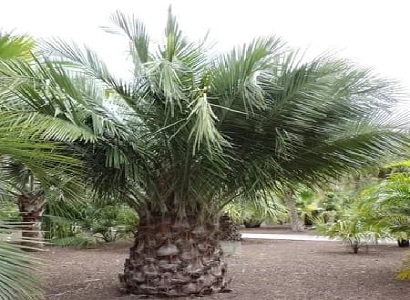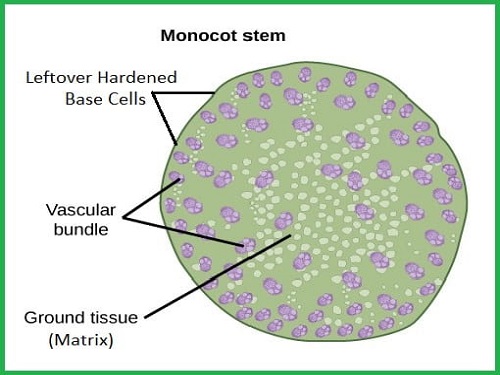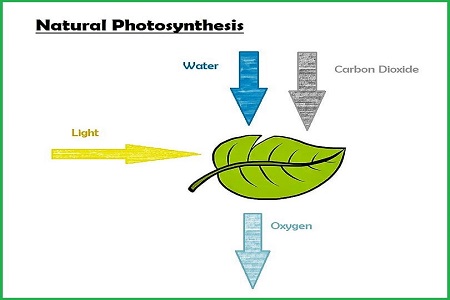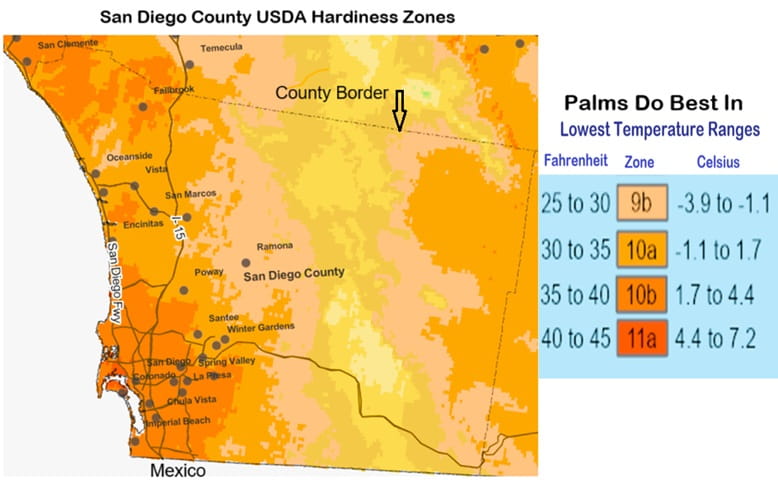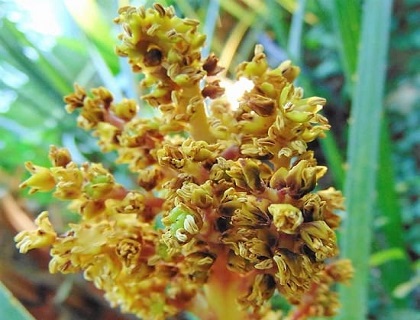- Home
- What are Palms?
- Inside a Palm
Inside of a Palm Tree
At Mission: Palm Trees
Palm lovers can soothe their palm-related searches and concerns. Our articles are intended to inform, while having fun, easily Finding What You Want or Need. Without unneeded shoptalk & tiring endless research. We Research For You!
What is inside of a palm tree? We'll help you take a journey into its core.
It's fun to see what's going on beneath palm surface areas. We've studies these innards, so we could get a grip on what's going on in there. Plus, to help you out for easily for understanding what's going on, too.
Try this captivating trip to look at a palm's inner workings, the secrets it holds within. Starting from the roots & going upward, we'll take you there.
Anatomy of a Palm Tree:
Understanding the Structure
INTRODUCTION
From the winding root system, then along the trunks - with all their varieties. Ending up in the leaf crown, with the structure of the fronds.
We were amazed to find the uniqueness there, inside of a palm tree. When we first learned this stuff!
Like quite no other plant! We think you'll be amazed, too.
Parts of palms have exact purposes. Looking inside, you'll see the uniqueness the structures inside of a palm tree have. Crucial for a palm's growth & survival.
Pick out your interest by clicking a button. Or continue scrolling for the whole understanding.
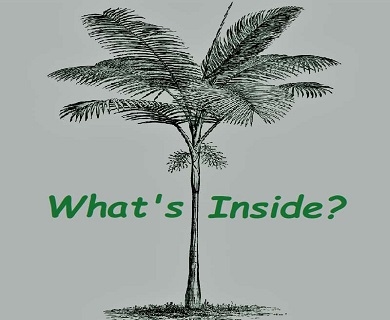
Close Look Inside a Palm's Roots
Various parts of a palm tree's roots begin their specialized action. Let's trace how that happens. Notice it first begins with the sprouting palm seed.
THE SEED GOES INTO ACTION
A newly planted palm tree seed has only one embryo, the one seed leaf. That's the inactive part of the seed that's ready to begin it all. It soon begins growing a starter root.
The seed sends out a sprout, forming the start of the root.
Not long after that, the Root Initiation Zone forms. It replaces that first sprouted root. Shaping itself at the stem's base.
Then depending on the Palm Species, extending a bit upward into the lower trunk.
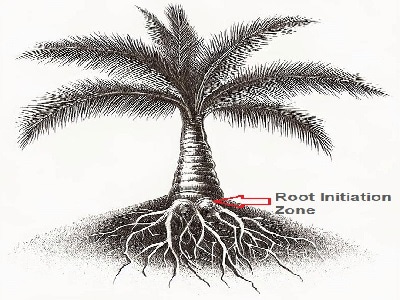
ROOT GROWTH
Growing out from the stem are those called adventitious roots.
These roots begin growing out at their full width. As you'll learn about the trunk, palm roots don't have secondary growth. The initial girth is as wide as they'll ever get.
They branch to three levels, though. Each somewhat thinner than the one before.
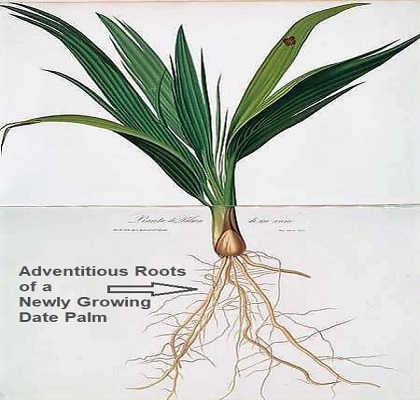
Palm roots can spread outward widely.
They anchor the palm firmly in the ground. Yet compared to woody trees, palm roots are somewhat shallow. Unlike a Palm Parts above ground, roots can regrow.
- If cut when transplanted. New roots form above the cut.
- The Root Initiation Zone can regenerate adventitious roots.
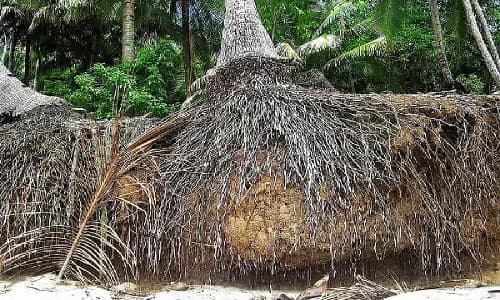 Undermined Roots Visible in This Toppled Over Palm
Undermined Roots Visible in This Toppled Over PalmBy a Shoreline
PALM ROOTS BRING FOOD
Root design is also kind of different, for a palm's nourishment. As opposed to woody trees, palm's primarily feed from the ground's upper soils. That's why we all know palms generally need regular watering.
- None produce root hairs.
- The task of the thinnest 3rd branch of roots is absorbing water & nutrients.
- Inner nourishment bundles have connections to the roots.
OTHER PALM TREE ROOT VARIETIES
Some palms develop roots above the soil.
- Stilt roots are a palm support system in some that grow in tropical rain forests.
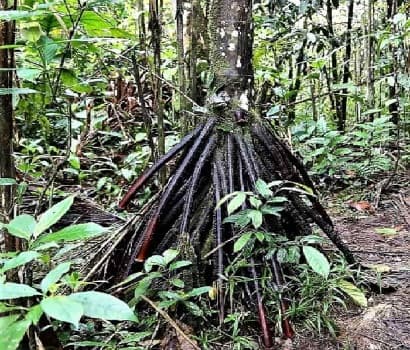 Iriartea deltoide Palm's Prop Roots Develop Over Time Not Seen When It's Young.
Iriartea deltoide Palm's Prop Roots Develop Over Time Not Seen When It's Young.Photo: Alexey Yakovlev @Flickr - CC BY-SA 4.0
- The Root Initiation Zone extends into view on some Date Palms. As they age, aerial root stubs can be seen at the trunk's bottom.
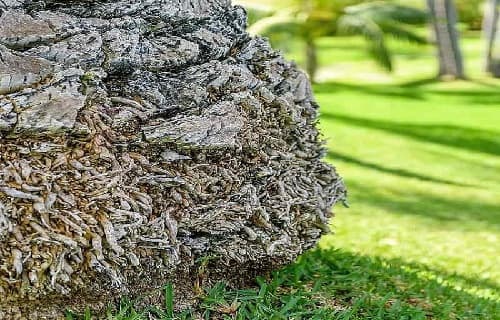 Aerial roots emerge on some palm species when they're older.
Aerial roots emerge on some palm species when they're older.Second level roots of some palms can absorb oxygen. They're called pneumatophores.
- Particularly in those palms of swampy environments. The soil there can't easily access the O2.
- Some even grow aerial roots called pneumatorhizae, which can absorb oxygen.
- The inside of a palm tree's pneumatophore has areas that seem to work like human lungs! Conducting gas exchange.
Inside of a Palm Tree Trunk
Palms grow with a single treelike trunk (also called stems). But also they can take a shrub-like form, with many trunks coming from the roots.
Surprising to many, trunks can grow vine-like. Climbing upward using another plant for anchoring.
Only the genera Hyphaene & Nypa produce branching trunks.
Whichever way they grow, the inside of a palm tree trunk will be the same. Although there are many styles to the trunk's outer covering. Which is not bark.
Palms aren't actually true trees. Their trunk functions are quite different from woody trees of forests & meadows. Like an oak, birch or spruce. These have an inner network to get their nourishment. Compared to blood vessel networks in humans.
Palms Don't Have These Pathways.
Instead there are separate bundled parts of the palm tree. They're scattered through the trunks & stems. These bundles use conductive tissues & tons of separate vascular strands. They transport water & nutrients throughout the plant.
This uniquely palmy system inside of a palm tree is its lifeblood.
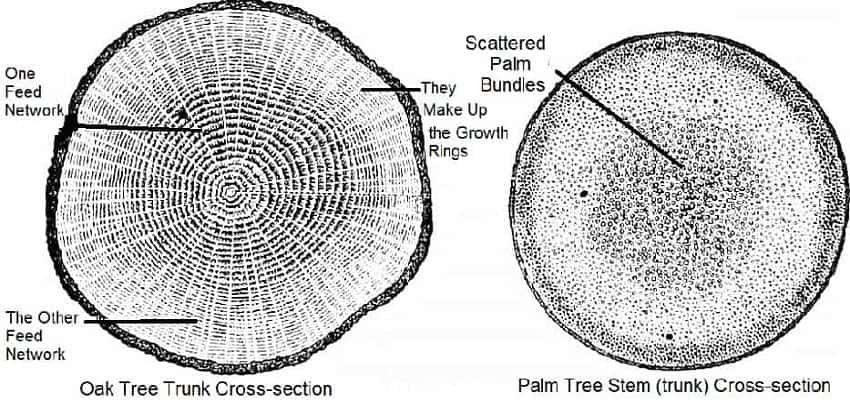
PALM TRUNK INSIDES MAKE THINGS DIFFERENT
Because of the inside of a palm tree trunk's structure, palm processes are distinct.
TRUNK'S YOUTH
- A trunk's first growth works on a minimal upward reach. Providing new growth of leaf bases protecting the palm's heart.
- At the same time it mostly works on reaching its greatest width.
- Once achieving that, it completes what's called the Establishment Phase. Then it begins growing further upward.
GROWING UP
With aging, inside of a palm tree trunk gets more solidly strong at the edges.
- Palms don't increase their trunk width by growing new wood, as secondary growth. In other words, they don't get thicker by forming yearly growth rings.
- As they age, all stems (trunks) basically stay the width they first grew to.
- Only sometimes, trunk bulges happen by swelling of individual inner cells. Or cell shrinking resulting from lengthy inadequate weather.
- Changes in trunk width aren't caused by adding new cells.
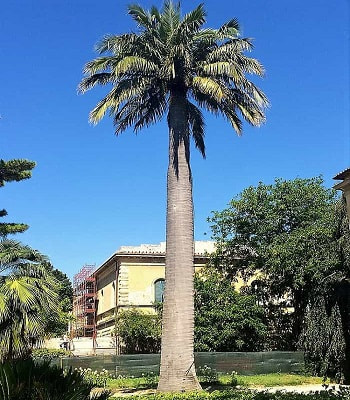 Jubaea chilensis (Syrup Palm)
Jubaea chilensis (Syrup Palm)Can Top Off at 78' Tall
Photo: Federigo Federighi - CC BY-SA 4.0
NOURISHMENT EFFECTS
As a Monocot Palm, the little nourishment packs that grow inside of the palm tree trunk are a finite number. So...
- Once the palm gets to its highest at maturity, no more are supplied.
- They can't multiply. Inside of a palm tree trunk, the plant won't produce any more.
- And if damaged & die, there is no method to repair or replace them.
GROWING EFFECTS
Palms inability to have secondary growth has other effects. During the establishment phase, they're at their most unstable time. If anything goes wrong, it will be difficult to overcome. Also...
- Grafting cannot work on a palm trunk.
- Continued growth & life depend on the growing point (heart or meristem), inside the trunk. If serious injuries happen to a trunk's meristem, there's no healing it.
- That results in death.
Inner Workings of Palm Leaves
How important are the insides of palm tree leaves?! They have a specialized structure made for capturing sunlight. Producing food in their cellular photosynthesis factories.
The newest true seedling leaves (eophylls) don't look at all like their adult form. They usually sprout with one (entire) seed leaf. Sometimes with two (bifid) leaves.
The first parts of a palm leaf (frond), are the sheath (base) & the petiole (stem).
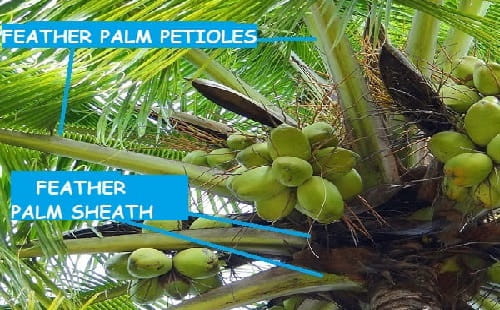 The Pinnate's Sheath & Petiole are Reinforced for Strength
The Pinnate's Sheath & Petiole are Reinforced for Strength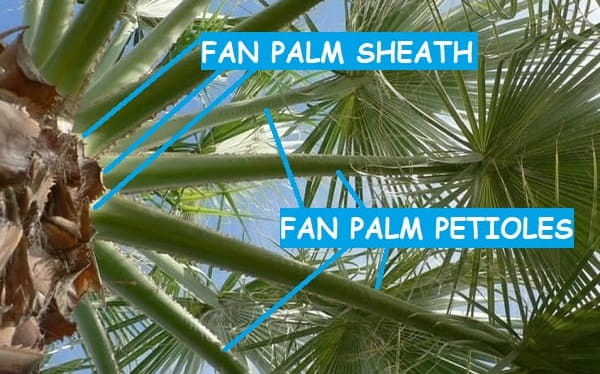 The Palmate's Sheath & Petiole are Reinforced for Strength
The Palmate's Sheath & Petiole are Reinforced for StrengthThese leaf stems are tube-like inside & have walls strengthened with masses of fibers.
- To endure weather stresses of the palm. While carrying water & nutrients to leaf tissues.
- Needed nourishment arrives at the palm's blade. With conducting tissues to supply food factories there.
- Using sun energy for photosynthesis. Which creates carbohydrates to nurture continued growth in the palm. Making flowers & fruit.
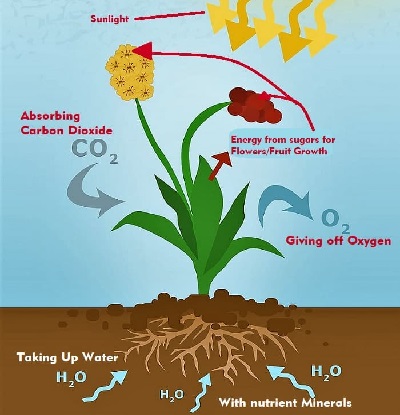
AGAINST THE WIND
Specialized parts are inside of a palm tree leaf. Helping the plant to weather a windstorm without damage. How is that you ask?
- Rather than being flat, blade areas of fronds are pleated to various degrees. Segments & leaflets are V-shaped (induplicate) or tent-shaped (ꓥ - reduplicate).
- This makes them stiffer, for wind resistance.
- And practical for palm lovers, as it helps with Palm Tree Identification.
The leaf base (sheath) supports these wind stresses, maintaining the frond on the stem.
Throughout the inner frond structure are ribs, braced with strong fibers.
The Latest at MPT
-
San Diego palm trees: History, Species, and Their SoCal Charm
Fascinated by San Diego palm trees? Discover their history, types, and why they're a staple of SoCal’s SD neighborhood scenery to inspire your landscape design.
Inside of a Palm Tree Flower
Most palm flowers are extremely small, with muted coloring.
They all grow out on an inflorescence. Which is the usually long & branched stalk for all the palm's flowers. Which are almost always closely set together. That's how palm flowers can look flashy.
The structure of inflorescences can help with Palm Identification. More details of the inner workings of palm flowering physiology are known. But really, much is unknown say notable botanists, still yet to be discovered.
BRACHTS are specialized leaves with a woody consistency. They protect young, growing inflorescences.
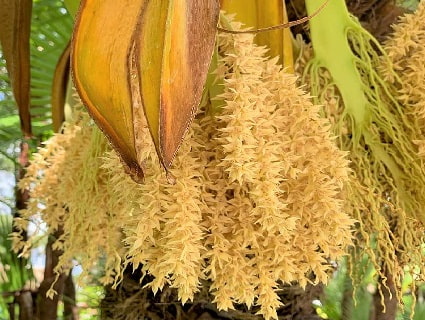 This is a Male Phoenix roebelenii - As a Dioecious Palm, Only Male Flowers Will Be Found Here.
This is a Male Phoenix roebelenii - As a Dioecious Palm, Only Male Flowers Will Be Found Here.Note the Brachts, which have now outgrown their usefulness for these flowers.
Pic: Katherine Wagner-Reiss - CC BY-SA 4.0
PALM FLOWER GENDERS
Flower structure in the palm world is quite variable. Yet palm flowers have 3 types of genders. Arranged on palm trees in several ways.
- Female flowers only with the pistil.
- Male flowers only with the stamen.
- Bisexual flowers have both male & female reproductive organs. They're termed "perfect."
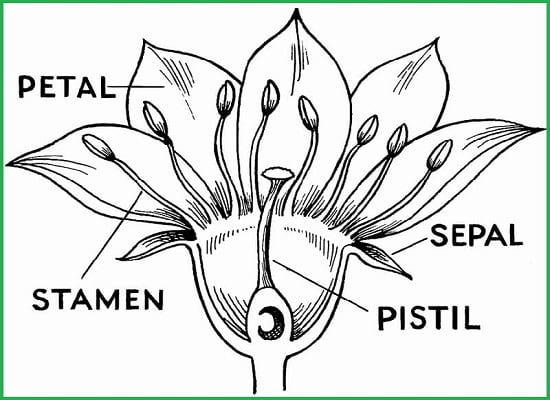
FLOWER ARRANGMENTS
Palm flower arrangement also varies. A lot depends on if they're Monoecious vs Dioecious.
- Monoecious palms have both gendered flowers all on the same palm plant. Usually interspersed by gender groups along the inflorescence. With each gender active at different times. (Better for no intra-palm pollination!)
- Rarely genders are separated onto their own inflorescence.
- Dioecious palms have flowers of one gender only on a plant. Males on one palm, females on another. Like these...
Mediterranean Fan Palm or European Fan Palm
The Chamaerops humilis is Usually Dioecious - BUT FOR EXCEPTIONS!
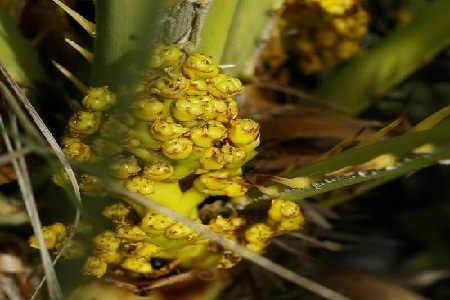 Mediterranean Fan Palm with only female flowers.
Mediterranean Fan Palm with only female flowers.Image ©Hans Hillewaert - Used With Permission
PALM FLOWER PARTS
Male Flowers - The stamen contains reproductive organ parts.
- At the top is the anther. It's a little bag that contains pollen.
- The stem of the anther is called the filament. It supports the anther. Very long & very narrow to help attract pollinators.
- Pollination process begins here with the male reproductive parts.
Female Flowers - The stigma contains reproductive organ parts.
- At the top is the stigma. Outer layer is tacky, so pollen will easily attach.
- The stigma's "stem" is called the style.
- The style leads downward to the ovary, which contains ovules (typically 3 of these egg cells).
Pollination - When the male's pollen reaches & sticks to the female's stigma.
- A Pollinator Attracted to the Flower, brushes against the male anther. Pollen sticks to the bee, ant, etc.
- Palm pollinators are often insects. Wind also helps, & don't rule out hummingbirds!
- Pollinators visit another flower (maybe on a different palm). Where the pollen gets stuck onto the female stigma.
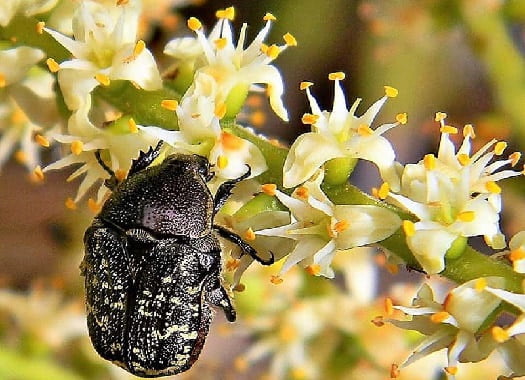 Scarab Beetle on Saw Palmetto Blossoms - Helps Pollination
Scarab Beetle on Saw Palmetto Blossoms - Helps PollinationBut Later When It Fruits, It's Back for the Eats!
Photo: Bob Peterson - CC BY-SA 4.0
Pollen sticks to the style.
Then works its way down the style, arriving at the female ovary. Starting the fertilization process, leading to fruit & seed production.
Inside of a Palm Tree's Fruit
Most Palm Tree Fruits are fleshy & contain one seed. With a thick covering around the inner seed. They're called drupes.
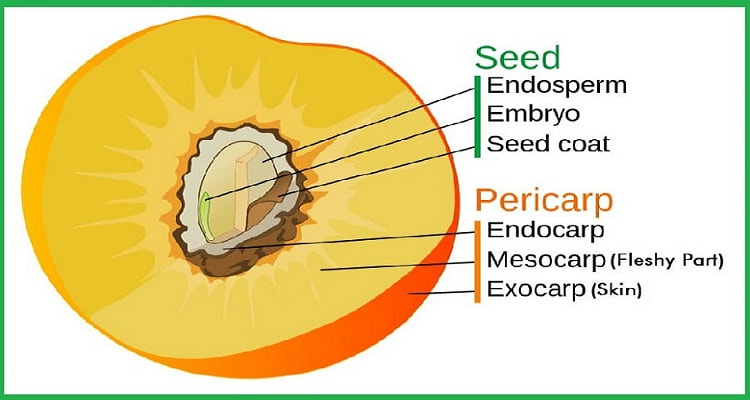
- If the inner seed covering is thin, then they're called berries.
On what's inside of a palm tree fruit, think of the term -carp. Coming from the Greek word Karpos, which related to mythology about bearing fruit.
- Peri- means around or surrounding, it's also in medical terminology. Pericarp means surroundings of the fruit.
- Endo- means inner for this case, so Endocarp is the inner part of the fruit.
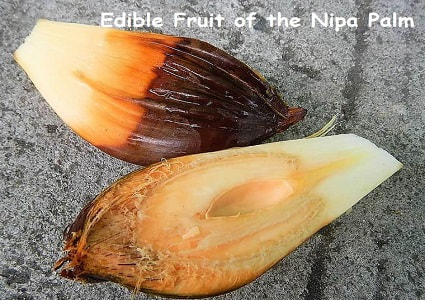 Nypa fruiticans Seeds are Also Edible.
Nypa fruiticans Seeds are Also Edible.The palm itself has many uses for local communities.
Survival Strategy:
The Secret to Palm Tree Resilience
The ways that the inside of a palm tree evolved gave them growth & nurturing capabilities.
But a side effect to this, was giving palms survival strategies. Helping them to thrive & continue growing in their endemic environments.
WHAT IS THAT SECRET SIDE EFFECT?
Their secret is how well palms stand up to strong winds. Well, let me stretch that a bit! As they won't stand up straight in behemoth wind storms. Like hurricanes or typhoons. I think you must've seen the photos of palms bending in a massive storm.
Some compare these side effects to reinforced concrete columns!
- The inside a palm tree trunk's central cylinder is built of a matrix of fibrous material. Compare it to poured concrete!
- Within that are the scattered nutritional bundles. They're very strong. Because lignin & cellulose continue depositing within them. For their entire lives. Compare these to steel rebar rods.
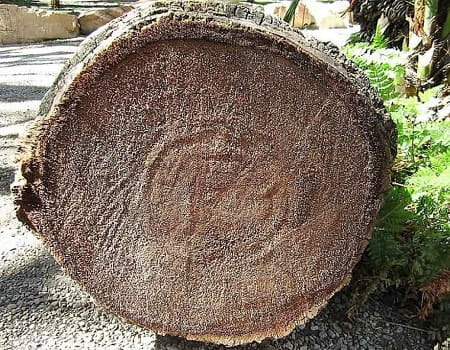 See the Inside of the Palm Tree Trunk
See the Inside of the Palm Tree TrunkTo Find There Are No Growth Rings
Photo: Kadeve - CC BY-SA 4.0
The outer edges are stronger & more dense than inner areas. Because of the inside of a palm tree trunk's construction. That's why palm trees usually sway & bend with the wind. And rarely do they break.
Now that you've seen much of the insides of a palm tree, we think you'll realize how unique these plants are!
Takeaways for the Inside of a Palm Tree
The structure of palms are totally different from the typical woodland tree. As they're not a true tree, at all. Many have a tree-like structure, called Solitary Palms. Others are more like bushes, referred to as Clumping palms.
Whatever the growing structure they take, palms have their own way of processing all they need. And coping with the world around them.
